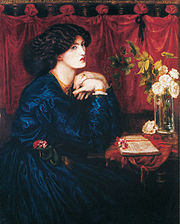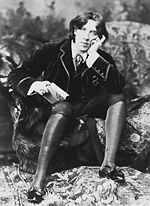
Artistic Dress movement
Encyclopedia

Artistic dress

Dante Gabriel Rossetti
Dante Gabriel Rossetti was an English poet, illustrator, painter and translator. He founded the Pre-Raphaelite Brotherhood in 1848 with William Holman Hunt and John Everett Millais, and was later to be the main inspiration for a second generation of artists and writers influenced by the movement,...
and other members of the Pre-Raphaelite Brotherhood
Pre-Raphaelite Brotherhood
The Pre-Raphaelite Brotherhood was a group of English painters, poets, and critics, founded in 1848 by William Holman Hunt, John Everett Millais and Dante Gabriel Rossetti...
were conscious archaizers, emulating the work of the "old masters" and choosing romantic, medieval subjects. They dressed their models in long flowing gowns loosely inspired by styles of the Middle Ages. These styles were then adopted by the painters' wives and models for everyday dress. Dresses were loosely fitted and comparatively plain, often with long puffed sleeves; they were made from fabric in muted colors derived from natural dye
Natural dye
Natural dyes are dyes or colorants derived from plants, invertebrates, or minerals. The majority of natural dyes are vegetable dyes from plant sources – roots, berries, bark, leaves, and wood — and other organic sources such as fungi and lichens....
s, and could be ornamented with embroidery in the art needlework
Art needlework
Art needlework was a type of surface embroidery popular in the later nineteenth century under the influence of the Pre-Raphaelites and the Arts and Crafts Movement....
style. Artistic dress was an extreme contrast to the tight corset
Corset
A corset is a garment worn to hold and shape the torso into a desired shape for aesthetic or medical purposes...
s, hoop skirts and bustle
Bustle
A bustle is a type of framework used to expand the fullness or support the drapery of the back of a woman's dress, occurring predominantly in the mid-to-late 19th century. Bustles were worn under the skirt in the back, just below the waist, to keep the skirt from dragging. Heavy fabric tended to...
s, bright synthetic aniline
Aniline
Aniline, phenylamine or aminobenzene is an organic compound with the formula C6H5NH2. Consisting of a phenyl group attached to an amino group, aniline is the prototypical aromatic amine. Being a precursor to many industrial chemicals, its main use is in the manufacture of precursors to polyurethane...
dyes, and lavish ornamentation seen in the mainstream fashion of the period.
In the 1860s, artistic dress became popular in intellectual circles and among artists for its natural beauty; it also reinforced their social ideals of quality materials, respect for the work of the hands, and the purity of medieval design.
Aesthetic dress

Tightlacing
Tightlacing is the practice of wearing a tightly-laced corset to achieve extreme modifications to the figure and posture and experience the sensations of a very tight corset. Those who practice tightlacing are called tightlacers...
, simplicity of line, and emphasis on beautiful fabrics), even though, at its core, Aestheticism
Aestheticism
Aestheticism was a 19th century European art movement that emphasized aesthetic values more than socio-political themes for literature, fine art, the decorative arts, and interior design...
rejected the moral and social goals of the Victorian Dress Reform movement that was its precursor. The Aesthetes' belief that the Arts should provide refined sensuous pleasure was a direct rejection of the reverence for simplicity and handwork propounded by William Morris
William Morris
William Morris 24 March 18343 October 1896 was an English textile designer, artist, writer, and socialist associated with the Pre-Raphaelite Brotherhood and the English Arts and Crafts Movement...
.
Aesthetic dress encompasses a range of modes, from the Japonaise gowns and Kate Greenaway
Kate Greenaway
Catherine Greenaway , known as Kate Greenaway, was an English children's book illustrator and writer, who spent much of her childhood at Rolleston, Nottinghamshire. She studied at what is now the Royal College of Art in London, which at that time had a separate section for women, and was headed by...
-inspired children's smocks
Smock-frock
A smock-frock or smock is an outer garment traditionally worn by rural workers, especially shepherds and waggoners, in parts of England and Wales from the early eighteenth century...
of Liberty & Co.
Arthur Lasenby Liberty
Sir Arthur Lasenby Liberty was a London merchant, and the founder of Liberty & Co.Born in Chesham, Buckinghamshire, England, the son of a draper, he began work at sixteen with his uncle who sold lace, and later, another uncle who sold wine...
to the velvet jackets and knee breeches of Oscar Wilde
Oscar Wilde
Oscar Fingal O'Flahertie Wills Wilde was an Irish writer and poet. After writing in different forms throughout the 1880s, he became one of London's most popular playwrights in the early 1890s...
's "aesthetic lecturing costume" for his speaking tour of America in 1882.
Influence on mainstream fashion
From artistic circles, artistic and aesthetic dress spread to fashionable ones. The delicate, lightly corseted tea gownTea gown
A tea gown or tea-gown is a woman's at-home dress for informal entertaining of the late 19th to mid-20th centuries characterized by unstructured lines and light fabrics. Early tea gowns were a European development influenced by Asian clothing, part of the japonism of Aesthetic dress...
s of the turn of the 20th century echo the lines of late aesthetic dress, and in their turn paved the way for the early Art Deco
Art Deco
Art deco , or deco, is an eclectic artistic and design style that began in Paris in the 1920s and flourished internationally throughout the 1930s, into the World War II era. The style influenced all areas of design, including architecture and interior design, industrial design, fashion and...
creations of Paul Poiret
Paul Poiret
Paul Poiret was a French fashion designer. His contributions to twentieth-century fashion have been likened to Picasso's contributions to twentieth-century art.-Early life and career:...
.
Gallery
- Early artistic dress: Symphony in White No. 1 by Whistler, 1862
- The young May Morris by Dante Gabriel Rossetti, 1872
- The wives and daughters of Morris and Burne-JonesEdward Burne-JonesSir Edward Coley Burne-Jones, 1st Baronet was a British artist and designer closely associated with the later phase of the Pre-Raphaelite movement, who worked closely with William Morris on a wide range of decorative arts as a founding partner in Morris, Marshall, Faulkner, and Company...
in artistic dress, 1874 - Countess Brownlow in artistic dress, 1879 .
- Liberty & Co. tea gown of figured silk twill, c. 1887. Los Angeles County Museum of ArtLos Angeles County Museum of ArtThe Los Angeles County Museum of Art is an art museum in Los Angeles, California. It is located on Wilshire Boulevard along Museum Row in the Miracle Mile vicinity of Los Angeles, adjacent to the George C. Page Museum and La Brea Tar Pits....
, M.2007.211.901 - Liberty art fabrics advertisement showing a young girl's dress with smocking, May 1888
See also
- The SoulsThe SoulsThe Souls were a small, loosely-knit but distinctive social group in England, from 1885 to about 1920. Their members included many of the most distinguished English politicians and intellectuals....
- Victorian fashionVictorian fashionVictorian fashion comprises the various fashions and trends in British culture that emerged and grew in province throughout the Victorian era and the reign of Queen Victoria, a period which would last from June 1837 to January 1901. Covering nearly two thirds of the 19th century, the 63 year reign...
- Victorian dress reformVictorian dress reformDuring the middle and late Victorian period, various reformers proposed, designed, and wore clothing supposedly more rational and comfortable than the fashions of the time. This was known as the dress reform or rational dress movement...
- 1860s in fashion1860s in fashion1860s fashion in European and European-influenced clothing is characterized by extremely full-skirted women's fashions relying on crinolines and hoops and the emergence of "alternative fashions" under the influence of the Artistic Dress movement....
- 1870s in fashion1870s in fashion1870s fashion in European and European-influenced clothing is characterized by a gradual return to a narrow silhouette after the full-skirted fashions of the 1850s and 1860s.-Overview:...
- 1880s in fashion1880s in fashionFashion in the 1880s in European and European-influenced countries is characterized by the return of the bustle. The long, lean line of the 1870s was replaced by a full, curvy silhouette with gradually widening shoulders. Fashionable waists were low and tiny below a full, low bust supported by a...

